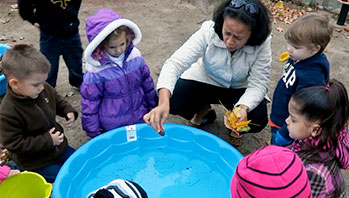- baking pans or cardboard box lids
- box or pail
- magnifying lenses
- small shovels or trowels
- spray bottle
- string
- dirt
- plant
- root
- seed
- soil
- worm
MA Standards
English Language Arts/Language/L.PK.MA.6: Use words and phrases acquired through conversations, listening to books read aloud, activities, and play.
Head Start Outcomes
Logic and Reasoning/Reasoning and Problem Solving: Classifies, compares, and contrasts objects, events, and experiences.
Science Knowledge/Scientific Skills and Method: Uses senses and tools, including technology, to gather information, investigate materials, and observe processes and relationships.
Science Knowledge/Scientific Skills and Method: Collects, describes, and records information through discussions, drawings, maps, and charts.
PreK Learning Guidelines:
English Language Arts/Language 2: Participate actively in discussions, listen to the ideas of others, and ask and answer relevant questions.
Science and Technology/Inquiry Skills 3: Identify and use simple tools appropriately to extend observations.
Science and Technology/Earth and Space Sciences 5: Compare and contrast natural materials such as water, rocks, soil, and living organisms using descriptive language.
Science and Technology/Living Things and Their Environment 15: Use their senses of sight, hearing, touch, smell, and taste to explore their environment using sensory vocabulary.
Explore Together (outdoors): More Soil Exploration

© Commonwealth of Massachusetts, Department of Early Education and Care. All rights reserved.
STEM Key Concepts: Plants grow in many places; Plants get their needs met from the environment (their habitat); Some plant parts are below the ground and some above
ELA Focus Skills: Listening and Speaking, Vocabulary
Educator Prep: Before the activity, go outside and mark areas for children to explore by marking off a small circle (about two feet across) with the string.
Safety Tips:
- Be aware of and check for poison ivy and poison sumac before gathering children in a designated area.
- Remind children to wash their hands before and after the activity.
- Remind children not to eat ANY plants or touch any plants without asking an adult.
- Take children’s allergies into account before going outside.
Tell children they are going to continue exploring outdoor plants and soil. Explain to children that today they are going to work in areas with a small group and take pictures to record their findings.
Discuss different ways children can explore. Make a list of children’s ideas for exploring. For example, ideas may include,
- Smell the dirt and describe it
- Feel the dirt and describe it
- Look at and describe the roots, seeds, worms, etc.
- Look at and describe the size of the worms
- Measure the roots and worms
- Measure the plants
Distribute magnifying lenses and have children work together to explore.
Take children out to the areas that you marked off. Have each group work in one area. As children explore things underground, watch and listen for opportunities to help them expand their curiosity. Ask questions such as,
- What happened when you sprayed the dirt with water?
- What do you think the worm would do if you put it in the sun? What did it do when you put it back in the dirt?
- How did the dirt feel as you dug deeper?
Reflect and Share
Encourage children to share their findings and their photographs. Help them reflect on their observations. Ask questions such as,
- Why do you think you are not finding any worms at the top of the dirt?
- How do you think those acorns and seeds get under the ground?
- What do you think the bird is looking for as he walks along the dirt?
Encourage children to record their findings by using the photographs to draw or by dictating a description for their science notebooks. You may also want children to tape the photograph in their science notebooks.
Educator Tip: Be aware of children who show a dislike for worms. Do not force them to touch the worms, but encourage them to take part in other parts of the activity.
Adaptation: For children with tactile sensitivities, you may want to have large spoons on hand so those children can join in the activity comfortably.
